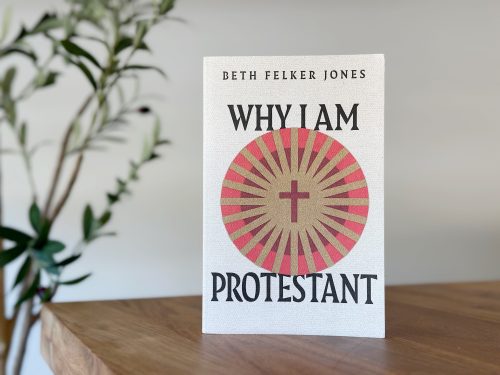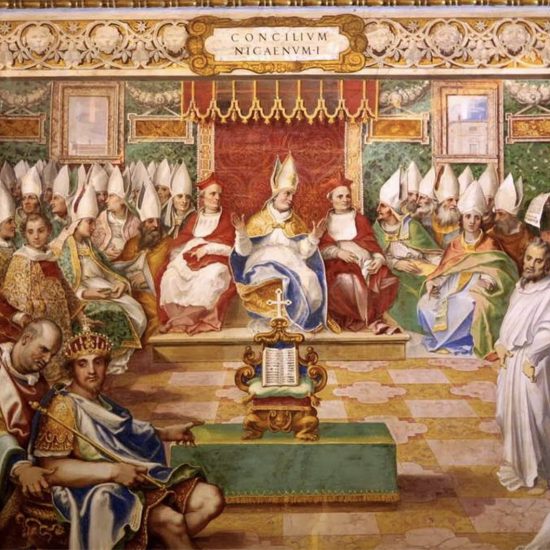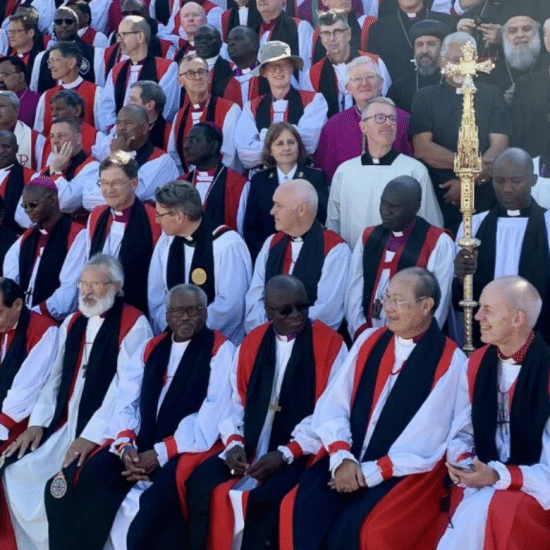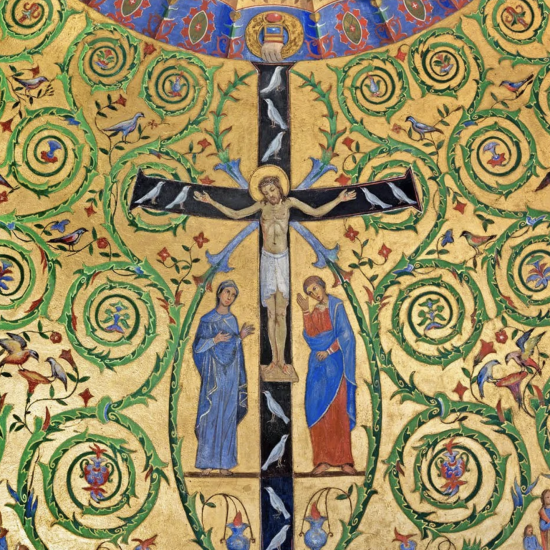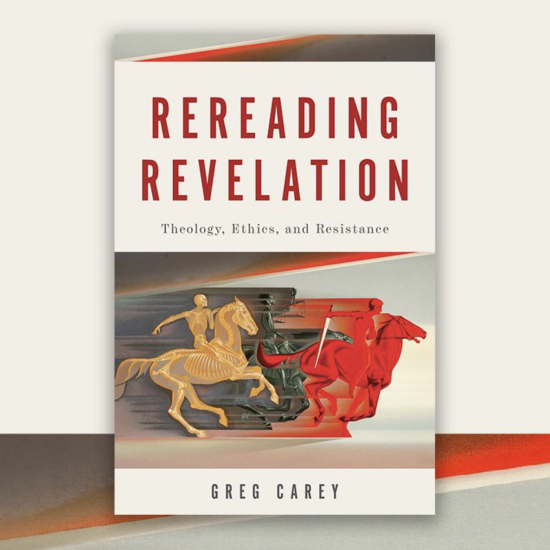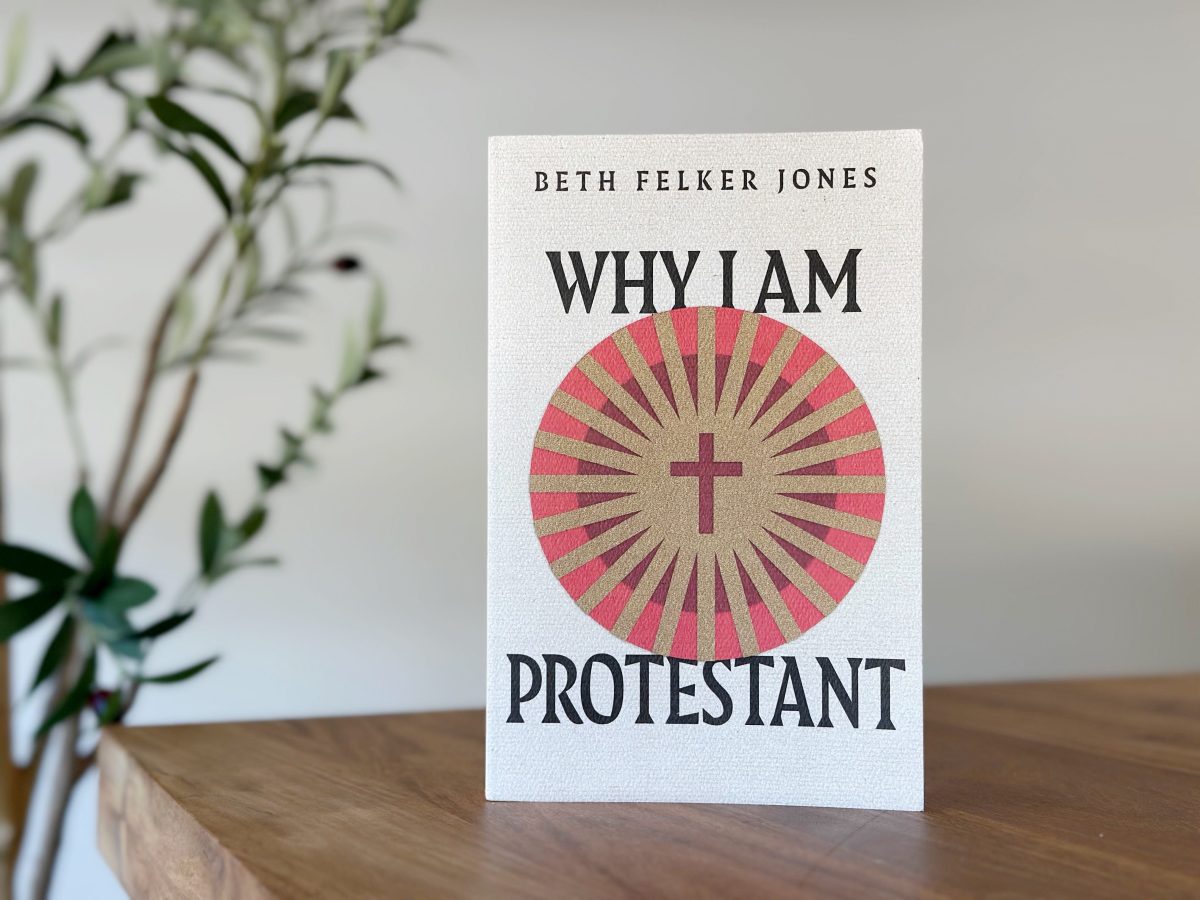
WHY I AM A PROTESTANT. By Beth Felker Jones. Downer’s Grove, IL: IVP Academic, 2025. X + 141 pages.
I was born and raised Protestant. In fact, during my childhood, the official name of the church of my birth was the Protestant Episcopal Church of America. Later on, the word Protestant was dropped, but it remains Protestant. Decades later, I’m still a Protestant, though I sometimes wonder what it is I’m supposed to be protesting. One thing I can say is that when it comes to the churches/denominations that fall under the Protestant umbrella, they’re not all on the same page. Protestantism runs the gamut from Pentecostal to Episcopal. Some are creedal and others are not. Some baptize by immersion on profession of faith, while others baptize infants with much less water. That said, the churches that live under the Protestant label have roots that go back to the Reformation, even if that connection is rather indirect. To say we are Protestant may come down to not being Roman Catholic (we’re not part of the Orthodox community, but we Protestants aren’t protesting against Eastern Orthodoxy).

Robert D. Cornwall
Having placed myself in the category of being a Protestant, I am ready to approach Beth Felker Jones’s book, Why I Am Protestant. This book is one of three in a series from IVP Academic, the other two being written by Roman Catholic (Matthew Levering) and Orthodox (not yet available) representatives. I’ve not read the other two books in this ecumenical series, but having read Jones’s book, I’m intrigued to read the others. As to the identity of the author of this book, Beth Felker Jones holds a PhD in theology from Duke University and teaches theology at Northern Seminary (historically an American Baptist seminary). She is, by choice, a United Methodist. While she respects the Roman Catholic and Orthodox traditions, she is a fully committed Protestant.
Jones acknowledges that “this book doesn’t provide a comprehensive account of Protestantism, whether historically, theologically, or globally.” Nevertheless, it does narrate her “own way of sorting through some key theological matters of Protestant Christian faith and life” (p. 3). One should not expect a comprehensive look at Protestantism in a book of 141 pages, but Jones does an excellent job of laying out the basic foundations of this tradition, always keeping in mind the fact that Protestantism is not monolithic and that Protestantism is not the only branch of the Christian tradition.
The first chapter of the book is titled “Why I Am a Christian.” I am assuming that each of the three books in the Ecumenical series begins in the same way. This is an appropriate place to start, since no matter what tradition one hails from, they (we) are first of all Christians and then members of our various traditions. This chapter does give Jones the opportunity to tell her own faith story. She narrates some of the basic foundations of the Christian faith, which are shared more broadly across traditions, such as the doctrine of the Trinity and the Chalcedonian position on Jesus.
While she is first and foremost a Christian, something she shares with other non-Protestant traditions, she is also more particularly a Protestant, which is the subject of the second chapter. Here she notes that some in her family and friendship circles have left Protestantism for Roman Catholicism. However, she remains firmly within Protestantism. She understands the frustration some feel about difficulties with interpreting scripture and concerns about religious authority. Nevertheless, she remains convinced that, at least for her, the Protestant way is best. She suggests that she is Protestant because she is catholic, that is, as a Protestant, she is part of the universal church. She is also orthodox as a Protestant, for it offers a way of being in right relationship with God. She is also Protestant because the tradition is Reformed. That is, it is rooted in a tradition of reform that includes the five solas that “testify to the heart of Protestantism, calling the church away from human sin and error and back to God alone” (p. 33). She concludes her chapter with this statement: “I am convinced that Protestant Christianity offers the most faithful and livable way for the church to follow its call to catholicity, orthodoxy, and reformed faith” (p. 35).
Chapter three is titled “How Protestantism Helps Me Be Christian.” Among the elements of Protestantism that she finds meaningful is the way it enables her to know God in a sinful world, especially through Scripture, which reveals God’s goodness, truth, and beauty amidst the brokenness of the church. One of the reasons Jones embraces the Protestant faith is that, in its fragmented state, it acknowledges being broken and imperfect. She finds this to be a good thing. She also finds within the Protestant tradition’s emphasis on scripture a path to intimacy with God. She also appreciates Protestant ecclesiology (though some might question whether there is such a thing) because of its diversity. Here she draws upon Augustine, especially his works on the challenge of Donatism (a schismatic movement that sought to create a pure church in the after Constantine’s embrace of Christianity). What she finds helpful in Augustine isn’t his contempt for Donatism or his dislike of institutional division. Rather, it is to be “found in his insight into the work of grace, even in a church he deemed theologically disastrous.” In what way did he do that? In recognizing that God could be at work even among the Donatists (p. 49). Thus, she appreciates an ecclesiology of grace rather than one that is institutionally focused.
In chapter four, Jones returns to the question of “Doing Church.” In this chapter, she makes use of the idea of “branch ecclesiology,” a perspective that has roots in Anglicanism. In using this concept, she speaks of the diversity of ecclesiologies within the larger church. Here again, she addresses the way the church exists, contrasting the Catholic institutionalism with Luther’s vision of the church as action. The focus is on what the church does, such as preaching the gospel, not its institutional dimensions. Again, she focuses on the idea of unity in diversity, using the branch theory. Thus, unity is found not in the branches but in the root, which is Jesus. She writes that “Branch ecclesiology helps us to imagine a church that is both universal and local, one that draws its vitality from living connection with the one root, the Jesus of the Gospel” (p. 65). Ultimately, she embraces an ecclesiology that counts every church as a church.
While Jones is fully committed to the Protestant principle, she acknowledges “The Difficulties of Protestantism” (Chapter 5). She writes, rightly, that every tradition has its strengths and weaknesses. The weaknesses present in Protestantism include its tendency toward individualism, fragmentation, and the nature of authority. The first two are fairly obvious. As for the third area of concern, that of authority, the issue is a bit more complex. The authority of scripture is generally affirmed (sola scriptura), but even here, there are questions as to how scripture represents God’s voice due to competing interpretations of Scripture. While these are problems, there are strengths as well, including the possibility of religious toleration and religious freedom. Thus, despite its messiness, sola scriptura has its benefits. In part, this is due to the recognition that the church itself is not perfect as an authority. Ultimately, there is the possibility of a peaceful pluralism of traditions, which can prove valuable.
While Protestantism has its weaknesses, in chapter six, Jones speaks of “The Peculiar Strengths of Protestantism.” For Jones, one of the reasons for staying is that the Protestant tradition has proven to be a loving home. This is due to several elements of the tradition, beginning with “Gratia” or Grace. Again, she looks back to Augustine for help, recognizing that Luther, among others, looked to Augustine’s emphasis on grace as helpful in the reform effort. Thus, Protestantism privileges grace as foundational. While the church is good and God chooses to work through it, it is broken. Thus, it is God’s grace that sustains us amid this brokenness. She points to the unity of the baptismal font and the Lord’s table as signs of that graciousness (though we still struggle with the Table).
The penultimate chapter is titled “Hopes for Christian Unity in Diversity” (Chapter 8). Having acknowledged that fragmentation is one of Protestantism’s weaknesses, she also affirms its allowance for diversity. So, how do we find unity in the midst of this diversity? Here she speaks of the “One Font, One Table.” I agree that the baptismal waters and the bread of heaven are central signs of the church, but I’m a little less sanguine when it comes to the oneness that exists within our churches. Nevertheless, there are commonalities among Protestants when it comes to these two sacraments. She also speaks of Protestantism representing a global faith, such that we are a diverse people. That again is true. It is becoming more diverse as new forms emerge, and local branches emerge that represent more contextual versions of the one faith. There is the possibility of flexibility here, which is a good thing. Thus, contextual diversity represents God’s love of different contexts. Ultimately, the final healing will not take place until we are “gathered around the thrown of the Lamb” (p. 124).
The final chapter lifts up three scriptural passages that Jones believes can prove valuable to Protestantism. They may not be the ones everyone would expect. Her suggestions include Ephesians 2:11-22 (breaking down dividing walls); 2 Timothy 3:10-177 (the one about the inspiration of Scripture); and Luke 1:46-55 (the Magnificat of Mary). I will let readers see why she chose these three, none of which speak to justification by grace through faith.
Beth Felker Jones, an admitted theology nerd and committed Protestant, in writing this brief volume titled Why I Am Protestant, invites readers to consider the strengths and weaknesses of the Protestant branch (branches) of the Christian faith. She offers a respectful view of other options, but finds that at least for her, Protestantism best represents her understanding of the Christian faith. As a Protestant myself, I largely resonated with her picture, though I might have questions at points. If you are not a Protestant but wondering what these folks believe, and admittedly, Protestants are a very diverse lot, then I believe you will find in Why I Am a Protestant a helpful guide. The same is true if you are a Protestant and you wonder why that is true!
This review originally appeared on BobCornwall.com.
Robert D. Cornwall is an ordained minister in the Christian Church (Disciples of Christ). Now retired from his ministry at Central Woodward Christian Church (Disciples of Christ) of Troy, Michigan, he serves as Minister-at-Large in Troy. He holds a Ph.D. in Historical Theology from Fuller Theological Seminary and is the author of numerous books, including “Eating With Jesus: Reflections on Divine Encounters at the Open Eucharistic Table” and “Second Thoughts About Hell: Understanding What We Believe” coauthored with Ronald J. Allen. His blog Ponderings on a Faith Journey can be found here.

